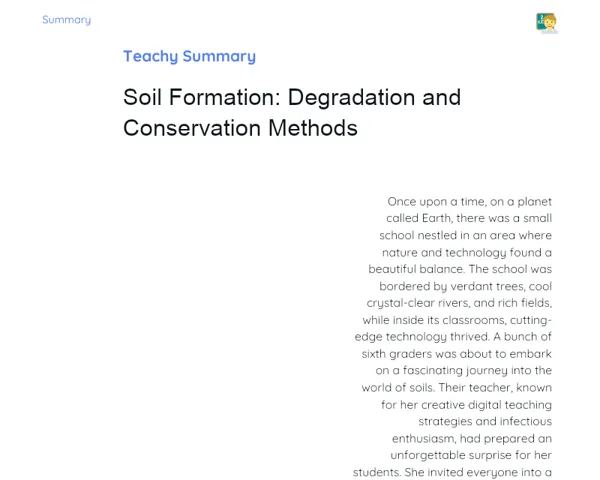Summary Tradisional | Geomorphology: Endogenous and Exogenous Agents: Review
Contextualization
The Earth's surface is always changing, shaped by internal forces known as endogenic agents and external forces called exogenic agents. Endogenic agents, including volcanism and tectonism, come from deep within the planet and are responsible for important events like mountain formation, earthquakes, and volcanic eruptions. These processes play a vital role in crafting the landforms and geological dynamics of our planet and directly affect how our landscapes are shaped.
On the flip side, exogenic agents work on the surface, transforming the landscape through processes like weathering, erosion, and sedimentation. Weathering breaks down rocks in place, while erosion carries these sediments away to be deposited elsewhere. The actions of climate and biological factors greatly influence these exogenic processes, making them essential for soil formation and the ongoing reshaping of the Earth's surface. Grasping the relationship between endogenic and exogenic agents is crucial for understanding physical geography and applying that knowledge in fields like agriculture, urban planning, and natural disaster management.
To Remember!
Endogenic Agents
Endogenic agents are the internal forces that significantly shape the Earth’s surface. Key endogenic agents include tectonism, volcanism, and orogenesis. Tectonism refers to the movement of tectonic plates that make up the Earth's crust, which can move apart, collide, or slide past each other, leading to the formation of mountains, earthquakes, and faults. Volcanism involves the eruption of magma from the Earth's interior to the surface, creating volcanoes and volcanic islands. Orogenesis describes the process of mountain formation typically caused by the collision and uplifting of tectonic plates, giving rise to ranges like the Himalayas and the Andes.
-
Tectonism: Movements of tectonic plates, including divergent, convergent, and transform boundaries.
-
Volcanism: Release of magma through volcanic eruptions, forming volcanoes and volcanic islands.
-
Orogenesis: Formation of mountains due to the collision of tectonic plates.
Exogenic Agents
Exogenic agents are external forces that affect the Earth's surface, gradually wearing down and reshaping it. The main exogenic processes include weathering, erosion, and sedimentation. Weathering involves the breakdown of rocks where they stand, without transporting the material elsewhere. This can be physical, chemical, or biological, each altering rocks in different ways. Erosion involves the wearing away and movement of soil and rock particles by water, wind, and ice, while sedimentation occurs when these materials are deposited in new locations, leading to features such as deltas and alluvial plains. These processes are influenced by climate, biology, and human activities, playing a vital role in soil health and the ongoing transformation of the landscape.
-
Weathering: Breakdown of rocks in place, which can be physical, chemical, or biological.
-
Erosion: Wearing down and transporting material via water, wind, and ice.
-
Sedimentation: Depositing transported materials, forming deltas and alluvial plains.
Interaction between Endogenic and Exogenic Agents
Understanding the interplay between endogenic and exogenic agents is essential for grasping how our landscapes function. Endogenic agents create the initial landforms through processes like the formation of mountains and volcanoes, while exogenic agents continually reshape these features. For instance, mountains formed by internal processes will experience weathering and erosion, slowly diminishing their stature over time. The eroded sediments may be carried by rivers and settle in flatter areas, giving rise to alluvial plains. This dynamic relationship between internal and external forces ensures that our Earth's surface is always evolving, leading to diverse landscapes and geological settings.
-
Endogenic agents create initial landforms (mountains, volcanoes).
-
Exogenic agents continuously reshape the land (weathering, erosion, sedimentation).
-
The ongoing interaction produces an ever-changing Earth’s surface.
Importance of Geomorphological Processes
Understanding both endogenic and exogenic geomorphological processes is crucial for numerous human activities. In urban planning, for instance, awareness of areas prone to earthquakes, landslides, and volcanic activity can inform safer construction methods. In agriculture, knowledge of weathering and erosion helps in protecting soil health and boosting productivity. Additionally, insights into geomorphological processes can aid in managing water resources and preparing for natural disasters, enabling communities to adapt to shifts in landscape and climate.
-
Urban planning: Identifying risk areas for safer building.
-
Agriculture: Protecting soil health and enhancing productivity.
-
Water resource management and disaster preparedness.
Key Terms
-
Geomorphology: The study of the shapes and forms of the Earth's surface and the processes that create them.
-
Endogenic Agents: Internal forces within the Earth, such as tectonism and volcanism.
-
Exogenic Agents: External forces acting on the Earth’s surface, such as weathering and erosion.
-
Tectonism: The movements of tectonic plates causing mountain building and earthquakes.
-
Volcanism: The eruption of magma from the Earth’s interior to create volcanoes.
-
Orogenesis: The process of mountain formation due to tectonic plate interactions.
-
Weathering: The breakdown and disintegration of rocks on the Earth’s surface.
-
Erosion: The process of wearing away and transporting rock and soil particles via water, wind, and ice.
-
Sedimentation: The accumulation of materials that have been transported by erosion.
Important Conclusions
The processes of endogenic and exogenic geomorphology are fundamental for a comprehensive understanding of the dynamic nature of the Earth's surface. Internal forces such as tectonism, volcanism, and orogenesis shape landforms like mountains and valleys and can trigger events including earthquakes. Exogenic processes such as weathering, erosion, and sedimentation actively reshape these features over time. Additionally, understanding these geological processes is vital across various domains such as urban planning, agriculture, and water management. This knowledge equips communities to implement proactive measures and adapt to ongoing changes in landscape and climate, enhancing safety and resilience.
Study Tips
-
Review the concepts of endogenic and exogenic agents by creating drawings and diagrams that illustrate how mountains and volcanoes are formed, along with the processes of weathering, erosion, and sedimentation.
-
Watch educational documentaries and videos about geological phenomena to visualize the processes discussed in class and understand their real-world implications.
-
Engage with articles and books focused on geomorphology and physical geology to deepen your theoretical understanding and explore specific geological transformations in different parts of the world.


